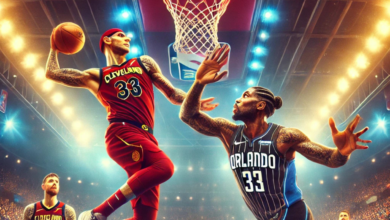Introduction to the Matchup
The clash between the Minnesota Timberwolves and the Golden State Warriors is always a spectacle, bringing a mix of raw talent, strategic gameplay, timberwolves vs golden state warriors match player stats and intense competition to the hardwood. Both teams, known for their unique playing styles and star-studded rosters, have consistently drawn fans and analysts into their narratives. This particular matchup, held at the vibrant Chase Center, was more than just another game; it had significant implications for playoff positioning and momentum heading into the latter half of the season.
Analyzing player stats is crucial in understanding the dynamics of such games. These numbers tell a story of how the game unfolded, spotlighting individual brilliance and team cohesion. In this breakdown, we delve into the performances that shaped the game, offering insights into how the Timberwolves and Warriors battled it out on the court.
Key Players and Their Contributions
Minnesota Timberwolves
Anthony Edwards: The young superstar was electric, showcasing his scoring prowess and ability to dominate in crucial moments. Edwards led the Timberwolves with a remarkable 32 points, demonstrating efficiency from both the field and the free-throw line. His quick decision-making and ability to penetrate the defense left the Warriors scrambling. Beyond scoring, Edwards contributed with seven rebounds and five assists, making him a pivotal part of Minnesota’s offensive and defensive strategies.
Karl-Anthony Towns: A dominant presence in the paint, Towns’ performance highlighted his dual-threat ability. Scoring 25 points and grabbing 12 rebounds, Towns was instrumental in controlling the boards and providing second-chance opportunities. His defensive efforts, including three blocks, helped keep the Warriors’ offense in check, particularly in the closing quarters.
Supporting players such as Jaden McDaniels and Rudy Gobert also played key roles, contributing with timely shots, defensive stops, and valuable minutes off the bench. Their combined efforts underscored the Timberwolves’ team-oriented approach.
Golden State Warriors

Stephen Curry: As always, Curry was the centerpiece of the Warriors’ attack. With 36 points, including six three-pointers, he dazzled the crowd with his shooting clinic. Curry’s ability to stretch the floor and create opportunities for his teammates was unmatched, keeping the Timberwolves’ defense on their toes throughout the game. His eight assists further highlighted his role as a playmaker.
Draymond Green: Known for his versatility, Green’s stat line of 10 points, 12 rebounds, and nine assists nearly earned him a triple-double. Beyond the numbers, Green’s leadership and defensive prowess were evident as he orchestrated the Warriors’ defensive schemes and provided crucial stops in high-pressure situations.
Contributions from Klay Thompson and Jordan Poole added depth to the Warriors’ offense. Thompson’s perimeter shooting and Poole’s aggression off the bench ensured the team remained competitive in critical stretches.
Comparative Analysis of Team Performance
Offensive Stats
Offensively, the Timberwolves showcased a balanced attack, with multiple players scoring in double figures. Their ability to score in the paint and capitalize on fast-break opportunities gave them an edge in efficiency. Shooting 48% from the field, the Timberwolves’ offensive execution was commendable.
The Warriors, on the other hand, leaned heavily on their perimeter shooting. While their three-point percentage of 37% was respectable, it paled in comparison to their usual standards. However, their ball movement, evidenced by 28 assists, highlighted their team-first approach and ability to create open looks.
Defensive Stats
Defensively, the Timberwolves excelled in rebounding, grabbing 52 boards compared to the Warriors’ 45. This advantage allowed them to limit second-chance opportunities and control the pace of the game. Their eight blocks and six steals showcased their active hands and interior presence.
The Warriors relied on their defensive rotations and experience to counter the Timberwolves’ aggression. Despite falling short in rebounds, their 10 steals demonstrated their ability to disrupt passing lanes and create turnovers.
Team Synergy
Both teams displayed moments of exceptional teamwork. The Timberwolves’ chemistry was evident in their ability to share the ball and make timely plays, while the Warriors’ experience and cohesion kept them in contention despite challenges.
Critical Moments and Game-Changing Plays
The game was filled with thrilling moments that kept fans on the edge of their seats. One of the turning points came in the third quarter when Anthony Edwards went on a personal scoring run, shifting momentum in favor of the Timberwolves. His ability to finish at the rim and hit contested jumpers energized his team.
Another pivotal moment occurred in the final minutes, with Stephen Curry hitting back-to-back three-pointers to narrow the gap. However, a critical defensive stop by Rudy Gobert, followed by a clutch three-pointer from Karl-Anthony Towns, sealed the game for the Timberwolves. The execution of plays in crunch time underscored the importance of composure and teamwork.
Conclusion
This matchup between the Timberwolves and the Warriors was a testament to the high level of competition in the NBA. Standout performances from players like Anthony Edwards and Stephen Curry showcased skill and determination. While the Timberwolves emerged victorious, the Warriors’ resilience and strategic adjustments kept the game competitive until the very end.
As the season progresses, both teams will look to build on this game’s lessons. For fans and analysts alike, the stats from this game highlight not only individual brilliance but also the importance of cohesive team play in achieving success.
FAQs
What were the key stats for Anthony Edwards in the match?
Anthony Edwards scored 32 points, grabbed seven rebounds, and dished out five assists, showcasing his all-around impact on the game.
How did Stephen Curry perform compared to his season averages?
Stephen Curry scored 36 points, slightly above his season average, and added eight assists, maintaining his reputation as a top scorer and playmaker.
Which team had the better defensive stats during the game?
The Timberwolves had a slight edge defensively, recording more rebounds (52) and blocks (8) compared to the Warriors.
What impact did bench players have on the outcome?
Bench players for both teams provided valuable contributions, with the Timberwolves’ depth helping them maintain momentum in critical stretches.
How did this game affect the playoff standings for the Timberwolves and the Warriors?
The win helped the Timberwolves gain ground in the standings, while the Warriors faced added pressure to secure a higher seed in the competitive Western Conference.
You May Also Read: https://ventsbuzz.pro/dallas-mavericks-vs-boston-celtics-match-player-stats/




